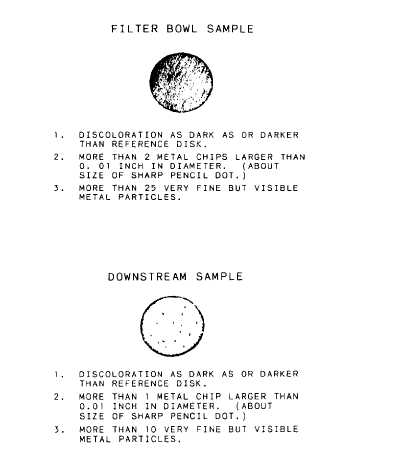Checks for Contamination
Whenever it is suspected that a hydraulic system has become excessively contaminated or the system has been operated at temperatures in excess of the specified maximum, a check of the system should be made. The filters inmost hydraulic systems are designed to remove most foreign particles that are visible to the naked eye; however, hydraulic liquid which appears clean to the naked eye may be contaminated to the point that it is unfit for use.
Thus, visual inspection of the hydraulic liquid does not determine the total amount of contamination in the system. Large particles of impurities in the hydraulic system are indications that one or more components in the system are being subjected to excessive wear. Isolating the defective component requires a systematic process of elimination. Liquid returned to the reservoir may contain impurities from any part of the system. In order to determine which component is defective, liquid samples should be taken from the reservoir and various other locations in the system.
FLUID SAMPLING. - Liquid samples should be taken according to the instructions provided in applicable technical publications for the particular system and the contamination test kit. Some hydraulic systems are provided with permanently installed bleed valves for taking liquid samples; while on other systems, lines must be disconnected to provide a place to take a sample. In either case, while the liquid is being taken, a small amount of pressure should be applied to the system. This ensures that the liquid will flow out of the sampling point and thus prevent dirt and other foreign matter from entering the hydraulic system. Hypodermic syringes are provided with some contamination test kits for the purpose of taking samples.
CONTAMINATION TESTING. - Various procedures are recommended to determine the contaminant level in hydraulic liquids. The filter patch test provides a reasonable idea of the condition of the fluid. This test consist basically of filtration of a sample of hydraulic system liquid through a special filter paper. This filter paper darkens in degree in relation to the amount of contamination present in the sample and is compared to a series of standardized filter disks which, by degree of darkening, indicates the various contamination levels. The equipment provided with one type of contamination test kit is illustrated in figure 10-37.
When you are using the liquid contamination test kit, the liquid samples should be poured through the filter disk (fig. 10-37), and the test filter patches should be compared with the test patches supplied with the test kit. A microscope is provided with the more expensive test kits for the purpose of making this comparison. Figure 10-38 shows test patches similar to those supplied with the testing kit.
To check liquid for decomposition, pour new hydraulic liquid into a sample bottle of the same size and color as the bottle containing the liquid to be checked. Visually, compare the color of the two liquids. Liquid which is decomposed will be darker in color.
At the same time the contamination check is made, it may be necessary to make a chemical analysis of the liquid. This analysis consists of a viscosity check, a moisture check, and a flash point check; however, since special equipment is required for these checks, the liquid samples must be sent to a laboratory where a technician will perform the test.
Flushing the System
Whenever a contamination check indicates impurities in the system or indicates decomposition of

Figure 10-38. - Hydraulic fluid contamination test patches.
Continue Reading